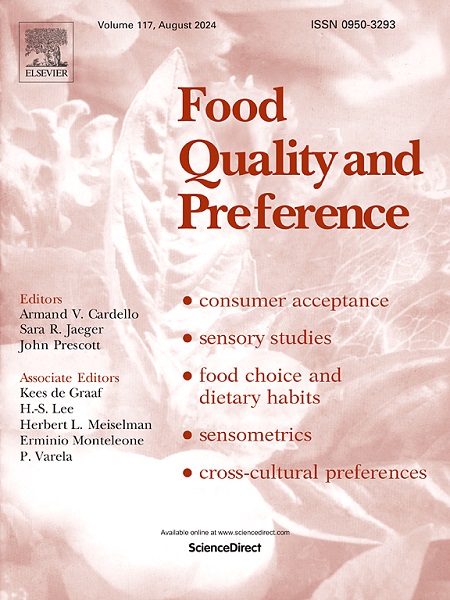某些食物的选择有何不同?从与社会和健康相关的决定因素入手,探索性分析 "营养行动家庭队列 "中夫妻的食物选择模式
IF 4.9
1区 农林科学
Q1 FOOD SCIENCE & TECHNOLOGY
引用次数: 0
摘要
食物的选择决定了身体过程所需的营养和能量的摄入,对个人的健康和福祉起着至关重要的作用。然而,一个人选择吃什么和怎么吃,在很大程度上是由原生家庭的社会化以及后来的社会化背景(例如,通过传记过渡或恋爱关系)形成的。尽管如此,食物选择在很大程度上还是作为个体化行为进行分析的。我们对 "营养行动家庭研究"(NutriAct Family Study)中招募的 402 对夫妇中的 803 个个体(男 = 64 岁;50% 为女性)自我报告的食物消费数据进行了主成分分析,以探索食物选择模式。我们探索性地得出了四种不同的食物选择模式,分别代表(1)植物性食物;(2)加工动物性食物;(3)低脂肪食物;(4)高糖甜食,它们之间存在松散的相关性(0.04 ≤ |r| ≤ 0.16)。在夫妇间层面,我们发现了性别差异,男性更倾向于动物性加工食品(t(756) = 10.17, p < 0.001, d = 0.72),女性更倾向于植物性加工食品(t(800) = -3.70, p < 0.001, d = -0.26)和低脂肪饮食(t(800) = -2.65, p = 0.008, d = -0.19)。此外,随着一对夫妇中退休人员数量的增加,他们在总体食物选择上的相似性也在增加(F(2799) = 8.15, p < 0.001, η = 0.02)。在所有四种食物选择模式中,夫妻层面对食物选择模式变异的解释均高于个体层面(0.62 ≤ ICC1 ≤ 0.78)。因此,我们得出结论,夫妻间的社会化在塑造食物选择方面发挥着核心作用,比普遍的性别角色或个人习惯更重要。本文章由计算机程序翻译,如有差异,请以英文原文为准。
What differentiates the choice of certain foods? An exploratory analysis of food choice patterns among couples from the dyadic NutriAct Family Cohort in relation to social and health-associated determinants
Food choices determine the intake of nutrients and energy for bodily processes and play a vital role for the health and wellbeing of individuals. However, the choice of what and how an individual eats is shaped largely by socialisation within the family of origin as well as later socialisation contexts, e.g., through biographical transitions or romantic relationships. Nonetheless, food choices have been analysed primarily as largely individualised practices. We performed principal component analyses on self-reported data on food consumption from 803 individuals (M = 64 years old; 50 % female) nested in 402 couples recruited within the NutriAct Family Study to explore food choice patterns. We exploratively derived four distinct patterns representing (1) plant-based, (2) processed animal-based, (3) low-fat, and (4) high-sugar sweet tooth food choices, which were loosely correlated (0.04 ≤ |r| ≤ 0.16). On an inter-couple level we found gender differences with men adhering more to the processed animal-based diet (t(756) = 10.17, p < 0.001, d = 0.72) and women more to the plant-based (t(800) = −3.70, p < 0.001, d = −0.26) and low-fat patterns (t(800) = −2.65, p = 0.008, d = −0.19). Additionally, as the number of retirees within a couple increased, so did the similarity between the partners in their overall food choice (F(2799) = 8.15, p < 0.001, η = 0.02). The couple level explained more variance in the food choice patterns than the individual level across all four patterns (0.62 ≤ ICC1 ≤ 0.78). We thus conclude that socialisation in couples plays a central role in shaping food choices, more so than prevalent gender roles or individual practices.
求助全文
通过发布文献求助,成功后即可免费获取论文全文。
去求助
来源期刊

Food Quality and Preference
工程技术-食品科技
CiteScore
10.40
自引率
15.10%
发文量
263
审稿时长
38 days
期刊介绍:
Food Quality and Preference is a journal devoted to sensory, consumer and behavioural research in food and non-food products. It publishes original research, critical reviews, and short communications in sensory and consumer science, and sensometrics. In addition, the journal publishes special invited issues on important timely topics and from relevant conferences. These are aimed at bridging the gap between research and application, bringing together authors and readers in consumer and market research, sensory science, sensometrics and sensory evaluation, nutrition and food choice, as well as food research, product development and sensory quality assurance. Submissions to Food Quality and Preference are limited to papers that include some form of human measurement; papers that are limited to physical/chemical measures or the routine application of sensory, consumer or econometric analysis will not be considered unless they specifically make a novel scientific contribution in line with the journal''s coverage as outlined below.
 求助内容:
求助内容: 应助结果提醒方式:
应助结果提醒方式:


